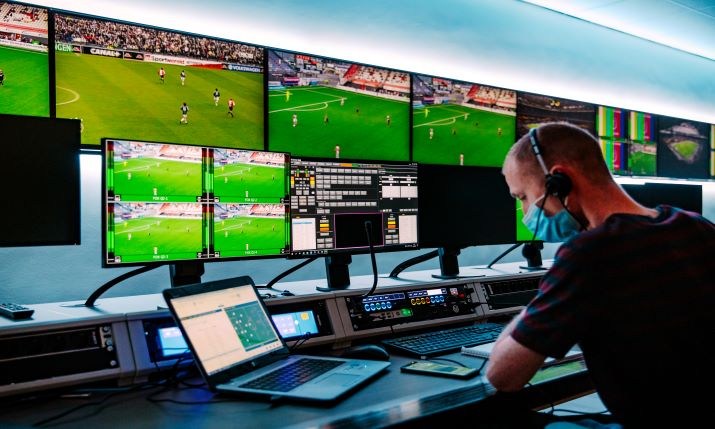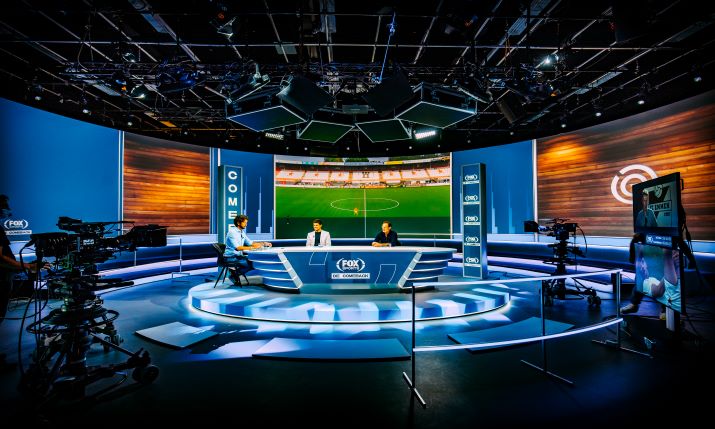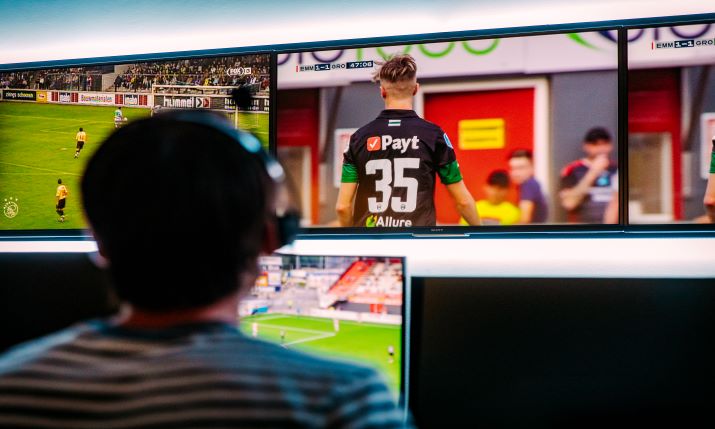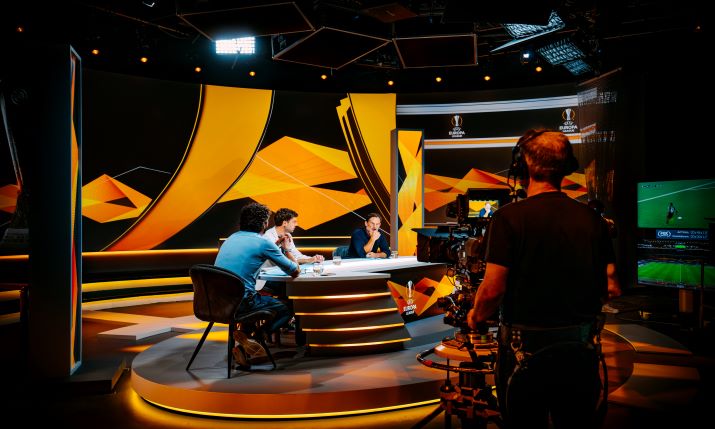Oranje football is back: Fox Sports Netherlands on robotic cameras, drones and no remote production

Football returns to TV screens in the Netherlands thanks to Fox Sports
Coronavirus has been a game-changer for the leagues and the sports broadcasting industry as a whole in the Netherlands. At the beginning of lockdown, the Dutch prime minister, Mark Rutte, took one of the harshest stances on preventing the spread of COVID-19 in Europe, proclaiming there would be no professional football played before 1 September.
Henk van Meerkerk, head of production at Fox Sports Netherlands, states that was a huge blow to the sports broadcasting industry in the country: “That was a big, big hit for the entire industry.”
Oranje football returns
However, finally, Dutch football is coming back. Says van Meerkerk: “The way we broadcast all the Dutch football is from our philosophy. Our directors [work on] all divisions, so the Premier Division, Eredivisie, the second division, Eerste Divisie, and the third division, Tweede Divisie, and we will even start with the women’s first division [Eredivisie Vrouwen] in the Netherlands as well, broadcasting as soon as the season starts. So we’re the leading broadcaster in [Dutch] football and not only as a broadcaster, but also as a producer.”
The football comeback in the Netherlands began on 31 July. Fox Sports is currently broadcasting exhibition games from all divisions after creating a schedule with the Dutch clubs to enable games to be played almost every day, filling the gap for fans still at home.
“We knew this summer would be very busy, but it turned out to be even busier because now we have all the Coronavirus issues to deal with. It’s a lot of work.”
Notes van Meerkerk: “It’s a combined schedule, so sometimes we have two Premier Division games playing together and sometimes two Second Division games, or sometimes it’s a Second Division game with a first; it’s a mix up from all the clubs and the two top tier leagues.”
That plan took viewers to the start of the second division season which began on 28 August, followed by the Premier Division on 12 September, “and then our regular season kicks off again,” says van Meerkerk.
Health and safety
Fox Sports has worked with the Dutch FA and the major leagues to create a health and safety protocol, which was sent to the Dutch government for approval. Once confirmed, matches could begin again.
Van Meerkerk states: “We knew this summer would be very busy, but it turned out to be even busier because now we have all the Corona issues as well that we have to deal with. So, we’ve been talking with the Dutch FA, and started with all the clubs, going to all their locations, and making new [health and safety] protocols for every game. So it’s a lot of work.”
Fox Sports already uses a lean plan for staff on-site at football matches. This meant when the broadcaster submitted its protocol plan for crewing games in the ‘new normal’, it did not need to be cut back much further.

Fox Sports Netherlands’ new studios in Amsterdam were ripped out and replaced with help from NEP Netherlands during lockdown
Van Meerkerk explains: “We already work in a very efficient way, so we don’t really have to cut in our crew because even if we can go to a 16 camera configuration, it still fits in our protocol that is approved by our government.”
Once approval for the health and safety protocols had been gained, Fox Sports had to go to every football venue for each division to make up separate rules to enforce the protocols in each. This included configuring camera positions, with regard to the number of fans allowed within each stadium.
Meerkerk comments that the return to football has, “taken us a little bit more time than the other leagues, but we got there”.
Little remote production
Fox Sports is not keen on remote production for the comeback, for various reasons. Van Meerkerk explains: “We’ve been looking at remote production, but to be honest for the productions we have, you create the same problem [of social distancing] in a remote control room somewhere else; you still have to work with people [wherever you’re based] and it’s easy to find space, so we made all kinds of [safe] set ups in our OB trucks so everybody’s safe to work and that’s what happens so far.
“It looks like we will be on site in OB trucks for most of the [second division and Premier League] games. Just a couple of games in our first division we will operate remotely, but most of them will be done on site,” he adds.
Premier division matches, when carried out as remote productions, will be based at the Fox Studio galleries in its revamped Amsterdam-based studios.
He continues: “[Remote production] doesn’t really make sense for us in the Netherlands. Our [camera] configuration for the production of a game is different from those in the UK for example. First division UK games start at, I think, 11 or 13 cameras, something like that. We started six or eight, and then we add cameras to it [if needed].
“We have been looking at the possibility, if for example there was going to be a big match we would use 18 to 20 cameras, but that [wouldn’t be] on a regular basis. But if it’s going to happen somewhere during the season, then we’ve got to look at remote production and then probably we do a part remote production, so for our EVS operators, for example, or for shading. So we can still have a small crew on site and have all the other people somewhere else in the Netherlands.”
He adds: “Our big trucks are big enough to work [with social distancing]. If we need more space we can look at the space around the stadiums, or we can take extra trucks with us.”
Additionally, being based in a fairly small country also makes the need for remote production less necessary, as driving from the North of the country to the South takes only two hours, so sending crew and kit is cost efficient and fast, says van MeerKerk. “Wherever we go it’s a 10 hour in and out for a competition game; that’s hard to imagine in the US or Australia, or even in the UK, so that’s why we’re different.”

Fox Sports Netherlands is taking advantage of the current lack of crowds in stadiums to get new camera angles from robotic cameras and drones
Close to the action
Van MeerKerk also has personal reasons for ensuring key crew, such as the director, is always on-site. “The big personal reason behind it is I’m a director. So I think from a technical perspective, remote production is great; it’s beautiful. But from a personal perspective, I always say a director is like a coach of a football team.”
He explains that like a coach, he feels that a director has to be able to see the players in front of them in order to maintain a connection. He adds: “I need to look in the eyes of the guys who are working for me, I want to smell, I want to hear what’s going on.
“I think as soon as you start working in a remote production environment, the personal gap between your people on site and the people off site grows,” van MeerKerk goes on. “Now, I still know all the people working on site, but if we were going to work completely remote and [there was a new] cameraman who hadn’t slept well the night before because he has a young child, when he makes a mistake the first time, I don’t know what’s going on, so I don’t know to give him a chance to wake up a bit and get it right the next time. We can have a Skype conversation but as you know, it’s not really going to work. So that’s the reason why we still work this way.”
Drone perspectives
With no fans in stadiums, or very few at least, Fox Sports has been able to look at enhancing its coverage with new camera angles. “If there is no crowd, we can put cameras wherever we want, basically,” explains Meerkerk.
“So we were looking at camera angles that we can’t normally do. In some stadiums we’re [usually] quite high up with our main camera and the main close up camera. For the main camera that’s all right because that’s [the case] in all the stadiums. But at bigger stadiums such as Ajax, we went down [the stands to the pitch], because the shot just moves better. We have [put up] scaffolding in the stands to [create] new camera angles.”
Fox Sports has also been able to take advantage of the lack of crowds to be able to use drones within stadiums, which due to licensing are not generally allowed to fly above people. The shots are used to illustrate pre-game footage and highlights videos, although using them during live matches is potentially on the cards, says van Meerkerk: “Well, there are no crowds, so we have new possibilities!
“We’re flying above the stands and outside of the stadiums using race drones. [When the first division returns] we can create crazy shots! I’m so excited to start using drones, even in live [football matches], but that’s something for later on.”
Fox Sports is using a 50mm lens for wide-angle shots of around and above the stadiums, and a 32mm lens for close up, in-game coverage from the drone. Van MeerKerk says: “We can fly around and depending on the speed we fly at [the battery lasts] about 15 minutes. When the drone comes down, we just change the lens and it goes up again and then we shoot from a different perspective.”
He adds: “We have also looked at licensing for [using drones] even if the crowds are [present], to fly around the stadium.”

NEP has helped Fox Sports go cloud-based at MediaArena in Amsterdam this summer
Robotic camera personalities
Fox Sports is well known for its audio feeds from the dugout, and while it usually place a small camera between the subs benches to pick that up, without crowds it has been able to go much further, with a remote-controlled gyro-stabilised robotic camera called Agito with a Shotover head.
The robotic camera is allowed into Zone 1 – in the tunnel, the dugout, and even on the pitch during the coin toss – where camera operators are not currently permitted due to COVID-19 zoning restrictions, but a few producers are allowed to enter.
A camera operator called Kees, who has worked for many years with Fox Sports, would have previously been responsible for getting the dugout shots, operating a handheld camera between the benches, so the nickname for the Agito has become Kees-I, laughs van MeerKerk.
Van MeerKerk states: “It gives us shots that feel like handhelds or steadicams. We use the Agito for shots when we’re entering the pitch, the warm up and the coin toss. When we started using Kees-I, the players really started interacting with it. It was really good fun; we even got Kees-I playing football with them.”
Continues van MeerKerk: “We’ve been using Kees-I from between the benches on the coin toss from the referee, and we have great shots of when there was a drinking pause, so when [the players] go back to the dugouts, [and we have] audio also listening in on the coaches again.
“You can use broadcast cameras on [Agito] with long lenses. Even moving around on the pitch, the stability is amazing. It gives us the same perspectives that we already had, and it also gives us new perspectives, which is really nice.”
Enhanced audio rebellion
On audio, Van MeerKerk intends to use the sounds of the live stadium as much as possible in preference over virtual audio. He comments: “We have had a lot of talks in the Netherlands, like everyone, on [whether we] should add additional audio to our games.
“We had to deal with the new [COVID] situation. We always look at the bright side of life; we look from a positive point of view. Of course, we would like to have an audience as well, but if there’s no audience in the stadium, you will [just have to make] some new opportunities.”
He goes on: “All summer we didn’t have games, so we were able to look around and see what the other leagues were doing,” continues van MeerKerk. “And it is now up to us to decide what we think adds the most value to the viewing experience. Hopefully, the stadiums will be filled at some point during the regular season. But if not, if there is no crowd at all, we are going to do our best to offer the best alternative for the audience.”.”
All MeerKerk says the broadcast needs to be able to avoid using artificial crowd noise is an audience of at least 30% capacity in any stadium. He explains: “If it’s only 30% spectators in the stadiums and we don’t use artificial noise, we will [enhance their sound and] focus on [the fact that] the sound that isn’t actually there; that’s what it’s all about.
“It’s not about what we want to feel, it’s about what there is.”
The 2020-21 Eredivisie season starts on 12 September
